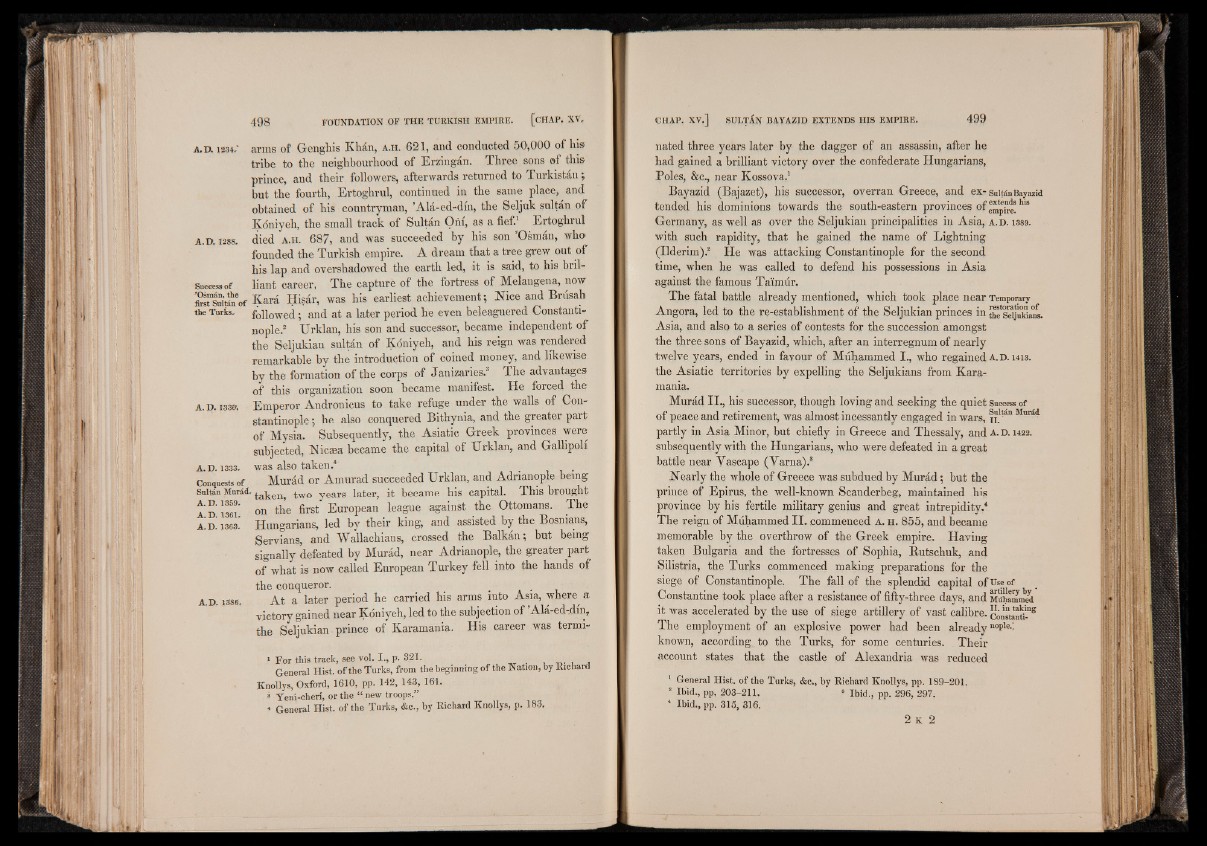
a. d . 1234." arms of Genghis Khán, a . h . 621, and conducted 50,000 of his
tribe to the neighbourhood of Erzingán. Three sons of this
prince, and their followers, afterwards returned to Turkistán;
but the fourth, Ertoghrul, continued in the same place, and
obtained of his countryman, ’Alá-ed-dín, the Seljuk sultán of
Kóniyeh, the small track of Sultan Oil, as a fief.1 Ertoghrul
a .d , Kgs. died a . h . 687, and was succeeded by his son ’Osmán, wlm
founded the Turkish empire. A dream that a tree grew out of
his lap and overshadowed the earth led, it is said, to his bril-
Successof liant career, The capture of the fortress of Melangena, now
Kara Hisár, was his earliest achievement; Nice and Brúsah
the Turks, followed; and at a later period he even beleaguered Constantinople.
8 Urklan, his son and successor, became independent of
the Seljukian sultán of Kóniyeh, and his reign was rendered
remarkable by the introduction of coined money, and likewise
by the formation of the corps of Janizaries.3 The advantages
of this organization soon became manifest. He forced the
A. d . la se . Emperor Andronicus to take refuge under the walls of Constantinople
; he also conquered Bithynia, and the greater part
of Mysia. Subsequently, the Asiatic Greek provinces were
subjected, Nicaea became the capital of Urklan, and Gallipoli
A. D . 1333. was also taken.4 _
Conquests of Murád or Amurad succeeded Urklan, and Adrianople being
Sultán Murád. ^ e n , two years later, it became his capital. This brought
A D i36i' on the first European league against the. Ottomans. The
A . d . 1363* Hungarians, led by their king, and assisted by the Bosnians,
Servians, and Wallachians, crossed the Balkán; but being
signally defeated by Murád, near Adrianople, the greater part
of what is now called European Turkey fell into the hands of
the conqueror. _
At a later period he carried his arms into Asia, where a
victory gained near Kóniyeh, led to the subjection of Alá-ed-dín,
the Seljukian prince of Karamania. His career was termi-
1 F o r this track, see vol. I ., p. 321.
General Hist, of the Turks, from the beginning of the N ation, by Richard
Knollys, Oxford, 1610, pp. 142, 143, 161.
3 Yení-cherí, or the “ new troops,”
* General Hist, of the Turks, &c., by Richard Knollys, p. 183.
A.D. 1386.
nated three years later by the dagger of an assassin, after he
had gained a brilliant victory oyer the confederate Hungarians,
Poles, &c., near Kossova,1
Bayazid (Bajazet), his successor, overran Greece, and ex-sultán Bayazid
tended his dominions towards the south-eastern provinces of hl8
Germany, as well as over the Seljukian principalities in Asia, a . d . 1389.
with such rapidity, that he gained the name of Lightning
(Ilderim).2 He was attacking Constantinople for the second
time, when he was called to defend his possessions in Asia
against the famous Ta'imdr.
The fatal battle already mentioned, which took place near Temporary
Angora, led to the re-establishment of the Seljukian princes in the^djukia'cs.
Asia, and also to a series of contests for the succession amongst
the three sons of Bayazid, which, after an interregnum of nearly
twelve years, ended in favour of Múhammed I., who regained a . d . 1 4 1 3 .
the Asiatic territories by expelling the Seljukians from Karamania,
Murád II., his successor, though loving and seeking the quiet Success of
of peace and retirement, was almost incessantly engaged in wars, h. ' Mu
partly in Asia Minor, but chiefly in Greece and Thessaly, and a . d . 14 2 2 .
subsequently with the Hungarians, who were defeated in a great
battle near Vascape (Varna).3
Nearly the whole of Greece was subdued by Murád; but the
prince of Epirus, the well-known Scanderbeg, maintained his
province by his fertile military genius and great intrepidity.4
The reign of Múhammed II. commenced a . h . 855, and became
memorable by the overthrow of the Greek empire. Having
taken Bulgaria and the fortresses of Sophia, Kutschuk, and
Silistria, the Turks commenced making preparations for the
siege of Constantinople. The fall of the splendid capital of Use of
Constantine took place after a resistance of fifty-three days, and Mühammed
it was accelerated by the use of siege artillery of vast calibre, q1’
The employment of an explosive power had been already n°Ple--
known, according to the Turks, for some centuries. Their
account states that the castle of Alexandria was reduced
1 General Hist, of the Turks, &c., by Richard Knollys, pp. 189-201.
” Ibid., pp. 203-211. 3 Ibid., pp. 296, 297.
4 Ibid., pp. 315, 316.
2 K 2